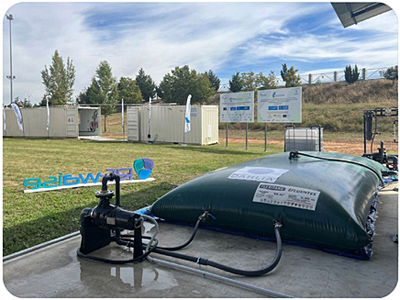 Sludge from EU wastewater treatment plants (WWTP) is heaping up, with 750 M citizens producing a yearly volume to fill the new Bernabeu Stadium in Madrid around 200 times with almost 100 Mm3/yr, counting around 17 Mt/yr of dry sludge when dewatered to between 20 and 25% dryness. And the new revision of the EU urban wastewater treatment directive is about to increase that quantity, exceeding the capacity of existing facilities and increasing further the high operating costs.
Sludge from EU wastewater treatment plants (WWTP) is heaping up, with 750 M citizens producing a yearly volume to fill the new Bernabeu Stadium in Madrid around 200 times with almost 100 Mm3/yr, counting around 17 Mt/yr of dry sludge when dewatered to between 20 and 25% dryness. And the new revision of the EU urban wastewater treatment directive is about to increase that quantity, exceeding the capacity of existing facilities and increasing further the high operating costs.
Nonetheless, the concept of circular economy enhances the need for recovery of energy, nutrients, and other products from biosolids. Conventional treatment of sewage sludge (both primary and secondary) by anaerobic digestion in mesophilic conditions at 37°C reduces its volume by about half, providing stabilisation for its use as fertilizer while producing biomethane, a renewable source of energy. Recently, improved pre-conditioning has intensified the digestion, including mechanical, chemical, thermal, biological processes – or a combination of them.
Aqualia has worked intensively on the development of innovative solutions for the efficient management of sewage sludge, transforming it into high value-added products and creating new opportunities for the circular economy.
One such innovative solution is DAHLIA®, the Decentralized Anaerobic digestion of biowastes by High-performance Low-cost system for Isolated Areas – which Aqualia developed to treat sludge of small WWTPs (<2,000 h-e), using simple polyethylene bags for anaerobic digestion. DAHLIA® has succeeded in improving sewage sludge treatment in terms of solids removal (67% DAHLIA® vs 42% conventional systems). This low-cost system allows to produce biogas in rural environments, and can be coupled to pre- or post- treatment, allowing advanced treatment to yield disinfected fertilizer.
For medium size WWTPs (2,000- 40,000 h-e), Aqualia equipped a low-cost anaerobic digester with an innovative heating system using 100% renewable energy (thermal and electric). This process, baptised Camellia, integrates thermal pre-treatment to increase biogas productivity and obtain a hygienized digestate that is easy to dewater, and is currently under start-up at Iscar WWTP.
Finally, for large WWTP, DUAL digestion couples thermophilic anaerobic and mesophilic digestion to achieve an increase of up to 35% in biogas production and solids destruction compared to conventional digesters. In addition, DUAL Digestion is geared towards co-digestion or industrial residues, thus offering efficient urban-industrial symbiosis for the management of biowaste.
In the DUAL digestion pilot plant designed and operated by Aqualia, with a capacity of 1500 and 5000 litres in the thermophilic and mesophilic reactors, respectively, sludge co-digestion assays have been carried out with vinasse. In these assays, a methane production of 400 L CH4/kg SVfed was achieved, which is a 16% increase compared to sludge digestion.
On an industrial scale, the codigestion process with different wastes is practised in different WWTPs such as Guijuelo, Guillarei, Lleida, Jerez or Salamanca.
In the latter, the three systems are operated within the framework of the Rewaise project (REsilient WAter Innovation for Smart Economy) to optimize them further. This project aims to create a new "smart water ecosystem", to integrate WWTP and anaerobic digestion into a carbonfree, sustainable hydrological cycle within a resilient circular economy. Nutrient Recovery, bioplastics extraction, sludge pre-treatment, enhanced and simplified anaerobic digestion as well as biogas posttreatment for biomethane production and CO2 recycling to obtain carboxylic acids are all part of a new biofactory approach, yielding high value products with a minimal carbon footprint.